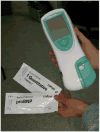Emergency Cardiac Biomarkers and Point-of-Care Testing: Optimizing Acute Coronary Syndrome Care Using Small-World Networks In Rural Settings
- PMID: 20577572
- PMCID: PMC2888163
- DOI: 10.1097/POC.0b013e3181d9d45c
Emergency Cardiac Biomarkers and Point-of-Care Testing: Optimizing Acute Coronary Syndrome Care Using Small-World Networks In Rural Settings
Figures






Similar articles
-
Suspected acute coronary syndrome in the emergency room: Limited added value of heart type fatty acid binding protein point of care or ELISA tests: The FAME-ER (Fatty Acid binding protein in Myocardial infarction Evaluation in the Emergency Room) study.Eur Heart J Acute Cardiovasc Care. 2016 Aug;5(4):364-74. doi: 10.1177/2048872615584077. Epub 2015 Apr 23. Eur Heart J Acute Cardiovasc Care. 2016. PMID: 25906779
-
Managing STEMIs without a Catheterization Lab: A Simulated Scenario to Improve Emergency Clinician Recognition and Execution of Thrombolysis in the Setting of Rural STEMI Management.J Educ Teach Emerg Med. 2024 Apr 30;9(2):S55-S77. doi: 10.21980/J8K933. eCollection 2024 Apr. J Educ Teach Emerg Med. 2024. PMID: 38707937 Free PMC article.
-
Point-of-Care Troponin Testing in Patients With Symptoms Suggestive of Acute Coronary Syndrome: A Health Technology Assessment [Internet].Ottawa (ON): Canadian Agency for Drugs and Technologies in Health; 2016 Mar. Ottawa (ON): Canadian Agency for Drugs and Technologies in Health; 2016 Mar. PMID: 27227213 Free Books & Documents. Review.
-
Three-month outcome of patients with suspected acute coronary syndrome using point-of-care cardiac troponin-T testing compared with laboratory-based cardiac troponin-T testing: a randomised trial.Emerg Med J. 2015 Aug;32(8):601-7. doi: 10.1136/emermed-2014-203958. Epub 2014 Sep 26. Emerg Med J. 2015. PMID: 25261004 Clinical Trial.
-
Point-of-care testing with high-sensitivity cardiac troponin assays: the challenges and opportunities.Emerg Med J. 2022 Nov;39(11):861-866. doi: 10.1136/emermed-2021-211907. Epub 2022 Jan 11. Emerg Med J. 2022. PMID: 35017187 Free PMC article. Review.
Cited by
-
Optimizing Global Resiliency in Public Health, Emergency Response, and Disaster Medicine.Point Care. 2012 Jun 1;11(2):94-95. doi: 10.1097/POC.0b013e31825a2409. Point Care. 2012. PMID: 23049469 Free PMC article.
-
Enhancing crisis standards of care using innovative point-of-care testing.Am J Disaster Med. 2011 Nov-Dec;6(6):351-68. doi: 10.5055/ajdm.2011.0074. Am J Disaster Med. 2011. PMID: 22338316 Free PMC article.
-
Geospatial Science and Point-of-Care Testing: Creating Solutions for Population Access, Emergencies, Outbreaks, and Disasters.Front Public Health. 2019 Nov 26;7:329. doi: 10.3389/fpubh.2019.00329. eCollection 2019. Front Public Health. 2019. PMID: 32039125 Free PMC article. Review.
-
Central laboratory and point-of-care cardiac marker testing capacity of tertiary hospitals in Nigeria - a multicenter study.Afr Health Sci. 2022 Jun;22(2):247-256. doi: 10.4314/ahs.v22i2.28. Afr Health Sci. 2022. PMID: 36407390 Free PMC article.
-
Assessing Point-of-Care Device Specifications and Needs for Pathogen Detection in Emergencies and Disasters.Point Care. 2012 Jun 1;11(2):119-125. doi: 10.1097/POC.0b013e31825a25cb. Point Care. 2012. PMID: 23049471 Free PMC article.
References
-
- Kost GJ, Peungposop N, Kulrattanamaneeporn C, et al. Minimizing health problems to optimize the demographic dividend: The role of point-of-care testing. In: Wongboonsin K, Guest P, editors. The Demographic Dividend: Policy Options for Asia. chapter 3. Bangkok: College of Population Studies, Chulalongkorn University; Asian Development Research Forum; and the Thailand Research Fund; 2005. pp. 56–89.
-
- Kost GJ. Fulbright Thailand. Vol. 10. Bangkok: Thailand-U.S. Educational Foundation; 2004. Aug, The Demography of Immediate Medical Care; pp. 7–8.
-
- Kost GJ, Tuntideelert M, Kulrattanamaneeporn S, et al. Fulbright Thailand. Vol. 13. Bangkok: Thailand-U.S. Educational Foundation; 2005. Jul, The Tsunami, POCT, and Future Disaster Planning; pp. 5–7.
-
- Kost GJ. Point-of-care testing in province hospitals and primary care units (PCUs): Optimizing critical care and disaster response. In: Charuruks N, Manarom W, editors. Point of Care Testing for Thailand. Chapter 10. Bangkok: 2006. pp. 159–177. In the Thai language.
-
- Kost GJ, Tran NK, Tuntideelert M, et al. Katrina, the tsunami, and point-of-care testing: Optimizing rapid response diagnosis in disasters. Amer J Clin Pathol. 2006;126:513–520. - PubMed
Grants and funding
LinkOut - more resources
Full Text Sources
